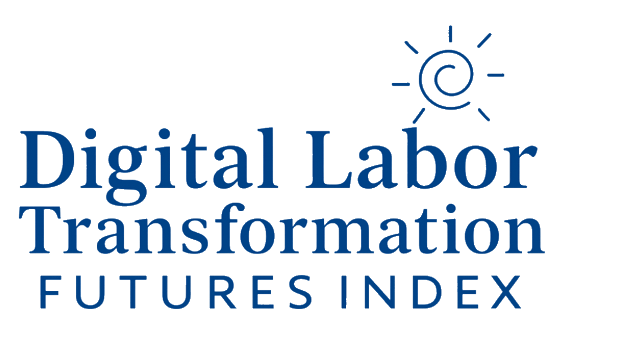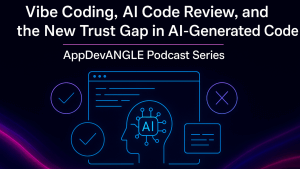Digital labor is no longer a future idea; it is becoming the defining operating model of modern businesses. Agentic AI systems that can perceive, reason, and act with increasing autonomy are quickly moving from pilot projects to full deployment, changing how organizations work and make decisions. As companies reach this point, many are reconsidering the very structure of their workforce, expanding it beyond human employees to include AI-powered digital coworkers embedded across business functions and workflows.
However, the path forward is far from easy. Fragmented strategies, weak governance, limited cross-functional ownership, and trust gaps threaten to halt progress and confine organizations to isolated pockets of automation instead of enabling true, enterprise-grade digital labor. The stakes are high: leaders must shift from tactical experimentation to a unified approach for building, deploying, and governing digital labor at scale.
To measure this shift with evidence rather than hype, theCUBE Research created the Digital Labor Transformation Index, one of five indices in the Agentic AI Futures program. Drawing on data from 625 pre-qualified AI and business leaders across 13 industries and 61 diagnostic questions, the Index evaluates organizational maturity. The 2025 average—3.1 out of 5—signals clear progress beyond experimentation but exposes a sizable gap between aspiration and execution.
Key findings from the Index reveal both accelerating momentum and structural fragility:
- Digital labor is now seen as inevitable: 90% of leaders believe AI agents will become core members of the future workforce, with confidence rising sharply among experienced adopters.
- Knowledge collaborators represent the next frontier: 65% now involve HR in planning, underscoring that this transformation is as much about people, culture, and skills as it is about technology.
- Organizations remain siloed by design: Only 16% believe responsibility for digital labor spans the enterprise—one of the clearest indicators of why execution lags.
- Trust is the determining factor for ROI: While automation confidence is high, only half strongly trust AI agents to operate autonomously. As our research shows, no trust means no scale, and no ROI.
The following sections unpack what the Index reveals about the scope, maturity, and constraints of digital labor transformation—and what it will take for enterprises to succeed in the decade ahead.
What is Digital Labor Transformation
Digital Labor Transformation is the enterprise-wide shift from task-based automation to AI-powered, knowledge-centric work performed by “digital coworkers” alongside human teams. It involves deploying agentic AI systems that can perceive context, reason about goals, take action across workflows, and continuously learn, fundamentally redefining how organizations execute work, make decisions, and deliver value.
Unlike traditional automation, digital labor transformation:
- Expands the workforce model to include AI agents as operational teammates.
- Elevates work from repetitive tasks to higher-order reasoning and decision flows.
- Requires new governance, trust, and organizational structures to ensure safe, transparent, and scalable adoption.
- Demands tight integration of people, process, and intelligent systems, not just technology deployment.
In short, digital labor transformation is not about replacing humans with automation; it is about rearchitecting the enterprise around hybrid human–AI work, where digital coworkers augment human capacity, accelerate outcomes, and unlock entirely new operating models. In essence, giving knowledge workers new “superpowers” to accomplish much more meaningful and impactful work.
Why Digital Labor Matters Now
Digital labor is not emerging in a vacuum; it is advancing at the exact moment when enterprises are under historic pressure to increase productivity, modernize operations, and close widening talent and capability gaps. The economic signals are unmistakable: organizations that do not integrate AI-powered digital coworkers into their operating models will fall behind competitors that do.
Industry benchmarks underscore both the scale of the opportunity and the urgency of acting now. McKinsey estimates that generative AI could boost global productivity by up to 3.4% annually, a transformational gain that rivals that of past industrial revolutions. But this upside depends entirely on whether organizations can overcome the governance, cultural, and operating-model barriers that have stalled previous technology transitions. In parallel, the World Economic Forum projects that 39% of core skills will shift by 2030, meaning enterprises must simultaneously deploy digital coworkers and reskill human teams to operate in hybrid human–AI environments. And according to PwC, 88% of executives plan to increase AI investments in 2026, signaling that strategic urgency is already surpassing organizational readiness.
In other words: the race is on.
These forces collectively indicate an early but rapidly maturing market, one where ambition is high, use cases are clear, and the competitive implications are becoming impossible to ignore. Yet as with every technological shift of this magnitude, execution is lagging behind aspiration. Many organizations are experimenting with automation and agentic AI, but few have the governance, cross-functional ownership, trust mechanisms, or workforce strategies required to operationalize digital labor at scale.
The result is a widening execution gap, between companies that are methodically building digital labor programs and those still dabbling at the edges. The former are already redesigning workflows, elevating human work, and laying the foundation for AI-driven productivity gains. The latter risk is structural disadvantage as markets consolidate around organizations that can deliver faster outcomes, better decisions, and more scalable operations.
The transformation is real and accelerating—but so are the risks of falling behind. For leaders, the imperative is clear: understanding where vision, strategy, and organizational maturity diverge is now essential. Those that establish trusted, scalable, and well-governed digital labor programs will define the competitive landscape of the next decade. Those that wait will struggle to catch up.
What the Digital Labor Transformation Index Reveals
One of the most striking findings of the Digital Labor Transformation Index is the sharp decline in maturity as organizations shift from aspiration to execution, supporting the notion that digital labor matters as a strategic competitive advantage. The data also confirms that an agentic AI strategy is not viewed as the same as a digital labor transformation strategy.
- Aspirations are high (4.1 score): On paper, leaders are enthusiastic in aggregate, with those with the most experience in AI and greatest familiarity with agentic AI leading the way.
- Strategy maturity is lower (3.1 score): This suggests that concrete plans are in place backed by real investment, but these efforts remain fragmented and uneven.
- Execution barriers are real (1.8 score): The notable decline emphasizes the implementation challenges related to cultural, technological, and trustworthiness factors.
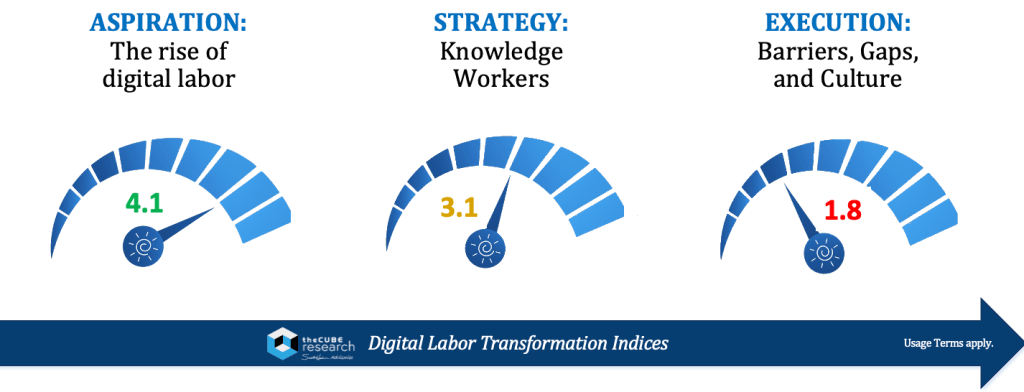
This highlights a clear Vision-to-Value gap. As Scott Hebner, principal analyst for AI at theCUBE Research, stated:
“A strategy without execution is hallucination.”
From which Christophe Bertrand, also a principal analyst at theCUBE Research, concluded:
“These are the signs of initiatives in their infancy. We’re still putting the foundations in place, and we’re years from where we want to be.”
The second top-line finding is that an agentic AI strategy is NOT viewed as being the same thing as a digital workforce transformation strategy. The data separates technology roadmaps (agents, orchestration, models, guardrails) from workforce roadmaps (roles, headcount models, new operating constructs with HR).
Ownership of execution must include cross-functional stewardship, yet only a small number report true cross-organizational structures (e.g., centers of excellence with HR, business, data, and compliance involved). This is why a strong Agentic AI plan does not automatically become a digital labor plan; they are related but distinct strategies serving different goals and owners.
Furthermore, the research indicates that digital labor is not about replacing human workers, but about augmenting them with new “superpowers“, helping people become more productive, make better decisions, and improve organizational collaboration in ways that were not possible before. In this model, humans and digital coworkers complement each other, creating a workforce that is greater than the sum of its parts.

Outside-in, this divergence shows up organizationally in the rise of the Chief AI Officer (CAIO), a role that, when done right, coordinates AI adoption and guardrails across business, technology, and risk, presenting a single plan to the CEO and the board. They are essentially becoming Digital HR leaders. Concurrently, 64% of organizations say their CHRO plays a strategic or significant role in fusing workforce strategies with Agentic AI. They oversee the strategy’s workforce productivity aspect, emphasizing the people-systems side of transformation. Per Scott Hebner:
“ [Agentic AI Strategy] is very different from the business strategy around your workforce. That’s where the real impact will be, bringing technology, business, and HR together.”
Why Digital Labor Matters Now
When it comes to aspirations, enterprise leaders are clear: digital labor is no longer a fringe idea; it is seen as inevitable. The survey data reveal that 71% of business leaders believe this generation will be the last to manage a human-only workforce. That is a striking statement, one that highlights how deeply the concept of hybrid organizations, where humans and AI agents work side by side, has taken hold in the executive mindset. In fact, only 10% show any level of disagreement.
This conviction explains why the Digital Labor Transformation Index scores aspirations at 4.1 out of 5. Leaders are not simply curious about digital coworkers; they expect them to be central to how work is defined in the years to come.
Part of this belief is rooted in competitive reality. Business leaders understand that organizations that can combine human and digital capabilities will gain structural advantages, including shorter cycle times, lower error rates, greater adaptability, and the ability to scale expertise more quickly than those relying solely on human workers.
Importantly, the data also shows that familiarity leads to conviction. Those with the most direct experience implementing AI and agentic workflows are the most likely to believe in the inevitability of digital labor. Larger enterprises also tend to be more confident, reflecting the scale-driven pressures they face to find new ways to boost labor productivity.
The aspiration data makes clear that enterprises are leaning in and that the conversation has shifted decisively from “if” digital labor will happen to “how fast” it will become mainstream. And, perhaps, even more importantly, the agentic AI technology strategy is giving way to a digital labor transformation strategy.
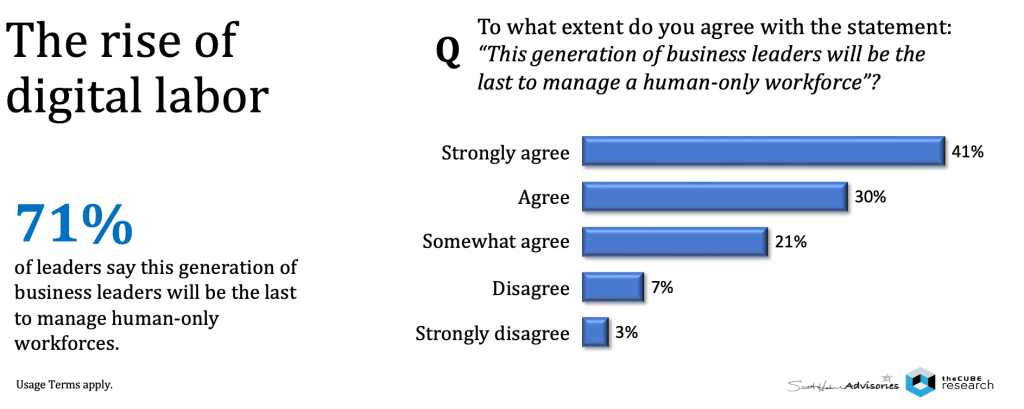
ddddd
If aspiration is about inevitability, strategy is about what organizations expect digital labor to actually do and how to make it happen. The survey reveals a decisive shift: digital coworkers are no longer viewed solely as tools for simple automation. Instead, enterprises increasingly envision them as knowledge workers, capable of solving problems, supporting decisions, and even pursuing goals with limited guidance.
The most common strategic use case remains automating routine or repetitive tasks (67%), showing continuity with earlier waves of robotic process automation (RPA) and enterprise workflow software. However, the true story lies just beneath the surface. Nearly as many leaders expect digital coworkers to help make better decisions (62%) and assist in diagnosing and solving business problems (60%). More than half (58%) believe agents will pursue goals with minimal human guidance, and 53% foresee them eventually acting autonomously on behalf of workers.
The Rise of Digital Co-workers
This vision signals a move away from thinking of AI purely as a back-office productivity booster and toward a more profound redefinition of knowledge work itself. Rather than simply processing transactions or crunching datasets, digital labor is being positioned to analyze, recommend, and act within the core workflows that drive competitiveness.
As Scott Hebner emphasized on the podcast,
“We’re moving from automation and analytics into knowledge work, where digital coworkers can reason, pursue goals, and collaborate alongside humans. This is becoming more real by the month”
Strategically, this reimagining of digital labor aligns with broader workforce and business priorities. Leaders recognize that while automation reduces cost, it is augmented decision-making and problem-solving that generate competitive advantage.
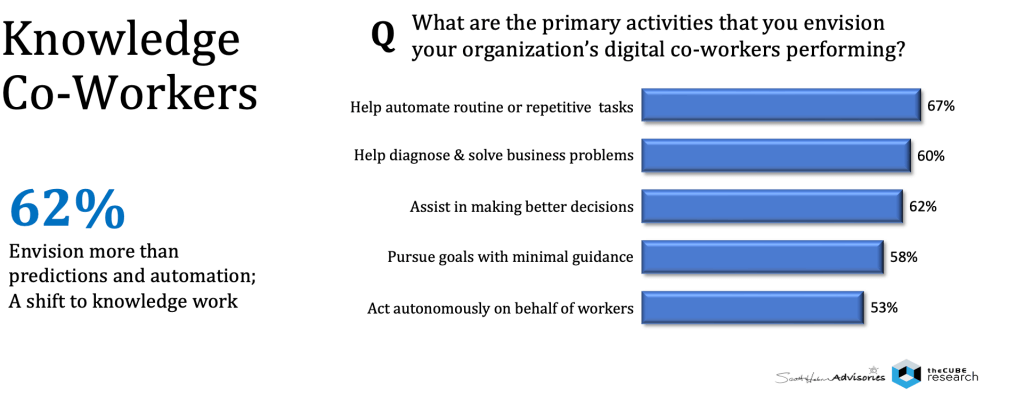
Workforce Culture and Governance Implications
Christophe Bertrand, appropriatrely, added a note of caution:
“Yes, the expectations are high, but can you trust them? Can you trust that an agent making a decision is doing it correctly, securely, and in compliance with policies?
Ultimately, the Index shows that organizations are not content with digital coworkers as simple automators. The strategy is to empower them as knowledge partners, a shift that, if executed well, will redefine not just productivity metrics but the very nature of enterprise value creation.
ADDD TRUST
Digital Labor is More Than A Technology Strategy
The Digital Labor Transformation Index reveals a sobering truth: most enterprises are falling short in their execution. With an average maturity score of just 1.8, it is clear that the collaborative strength needed to turn strategy into a scalable reality has not yet been developed.
The primary issue is ownership, specifically the lack of shared ownership. The survey indicates that 65% of organizations assign responsibility for digital labor implementation primarily to IT or application development teams, with an additional 20% pointing to data science or AI functions. While these groups offer vital technical expertise, implementation is mainly viewed as an engineering task rather than an organization-wide transformation.
By contrast, only 16% of respondents cite cross-functional teams, centers of excellence, or shared boards as the primary owners of digital labor execution. Even fewer report leadership by CxO-level executives (5%) or line-of-business units such as HR and operations (3%). A small minority (2%) admits ownership remains undefined. This lack of collaboration across business, HR, technology, and governance explains why execution maturity lags so far behind aspiration and strategy.
It’s the result of a “siloed by design” approach.
As Christophe Bertrand noted during the podcast discussion,
“Right now it’s still considered a technical implementation, but this is really a business play. Without cross-organization collaboration, things can head to the wall very quickly because there’s only so much you can ask IT to do for you.”
His point highlights the collaborative gap: while digital labor requires coordinated input from across the enterprise, most organizations are leaving execution in silos.
Bridging the collaboration gap requires more than just investing in technology. Companies need cross-functional centers of excellence that bring together IT, HR, business leaders, and compliance officers. Support from top executives, including the emerging Chief AI Officer role, must raise a technical project to a board-level workforce transformation strategy. Only then can organizations create the collaboration needed to turn today’s goals into future benefits.
The message is clear: execution is not just about technology, it’s about teamwork. Without it, digital labor stays isolated; with it, the true potential of a hybrid workforce can finally be achieved.
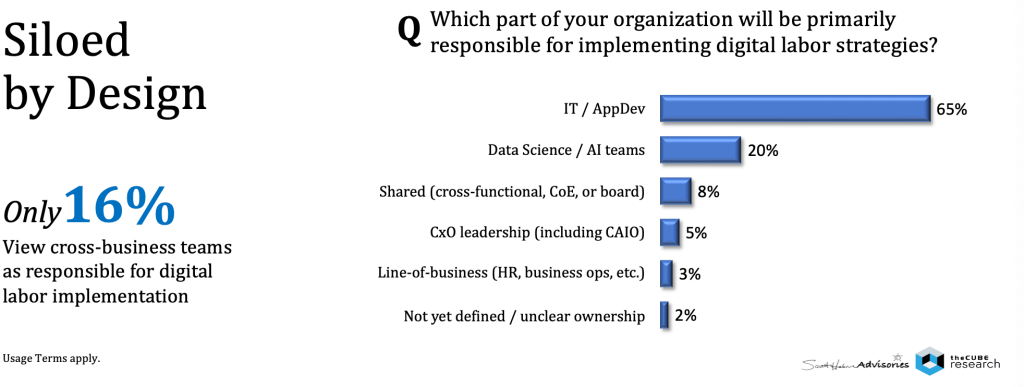
The Maturity Journey: From Automation to Agentic Work
Txxx
What Leaders Must Do Next
The Digital Labor Transformation Index clearly shows that although vision is high and strategic intent is strong, execution is falling behind. To close this gap, leaders need to shift their focus from isolated pilots to organization-wide collaboration. The next two years will be crucial. Some will lead successfully, some will fall behind, and others will fail as the shift to hybrid human-digital workforces becomes unavoidable.
Our conclusions from the research lead us to recommend the following:
- Separate but connect strategies: A technology roadmap for agents and automation isn’t the same as a workforce plan for roles, HR policy, and reskilling. Both are essential and must be managed as two sides of the same coin.
- Build a collaborative organizational engine: Execution cannot be left to IT alone. Councils or centers of excellence, co-led by HR, business leaders, and a CAIO, are the structures that turn intent into scaled outcomes anchored in ROI.
- Climb the value curve quickly: Automation is the starting point, but the real payoff comes when digital coworkers support knowledge work: making better, explainable decisions grounded in sound judgment and domain expertise.
- Double down on TRUST: Confidence in automation is high, but not in knowledge work. Focus on building cultural trust based on user involvement, true explainability, strong governance, and policy safeguards. No trust, no ROI.
- Endlessly communicate: Aspirations are surpassing execution, and that gap can harm confidence. Leaders should establish clear expectations, communicate progress transparently and honestly, and involve employees in the process.
Beyond that, looking toward 2025–2027, expect budgets to continue increasing, especially in large enterprises. Strategy efforts will shift toward standardizing roles and platforms, while execution maturity will depend on cross-functional governance and explainable workflows. And watch the talent market: CAIOs, AI risk managers, and HR transformation leaders are set to become some of the most sought-after roles in enterprise leadership.
Those who act quickly will seize the resilience, agility, and competitive advantage of a hybrid workforce; those who delay risk seeing ROI stagnate in silos.
Note that the Digital Labor Transformation index is part of the broader 2025 Agentic AI Futures Index, a five-part benchmark that measures key facets of enterprise readiness across:
- Digital Labor Transformation
- Agentic AI Technology
- Trust & Governance
- Reasoning & Decision Intelligence
- Causal AI Innovation
Together, these indices offer one of the first comprehensive roadmaps for leaders navigating the shift to agentic AI and digital labor. To explore industry-specific insights or co-develop a customized roadmap, contact me directly here or on LinkedIn. We’ll turn vision into action and digital labor into real business value.
In the weeks ahead, we’ll be previewing additional insights here on theCUBE Research portal and across LinkedIn, x, Substack, and Medium. Also, stay tuned for new episodes of The Next Frontiers of AI Podcast, where we will be unpacking the findings in partnership with industry pioneers and experts. Track or follow me on these properties to get the stream of data-driven insights to come.
Download a PDF overview of the Digital Labor Transformation Index here.
If you’d like to explore the complete data and analysis in more depth, or leverage the survey to sharpen your solution strategy or market positioning, or any of the use cases outlined in this post, please reach out here or connect with me on LinkedIn.
Watch the Podcast
Join Scott Hebner and Christophe Bertrand, both Principal Analysts at theCUBE Research, as they unpack fresh primary research data on the state of digital labor transformation. We reveal a striking workforce evolution underway where business leaders are no longer viewing agentic AI as simply a software automation or analytics paradigm shift, but as a genuine labor market phenomenon that promises to fundamentally change how work gets done.


